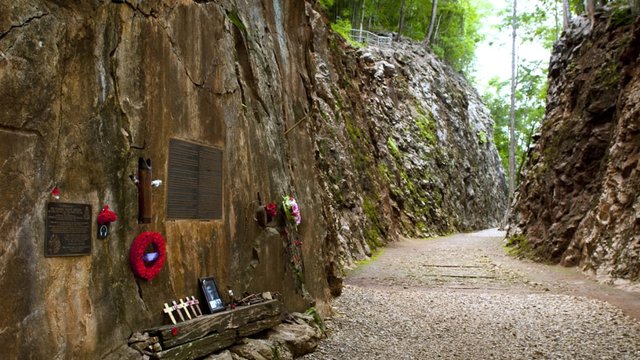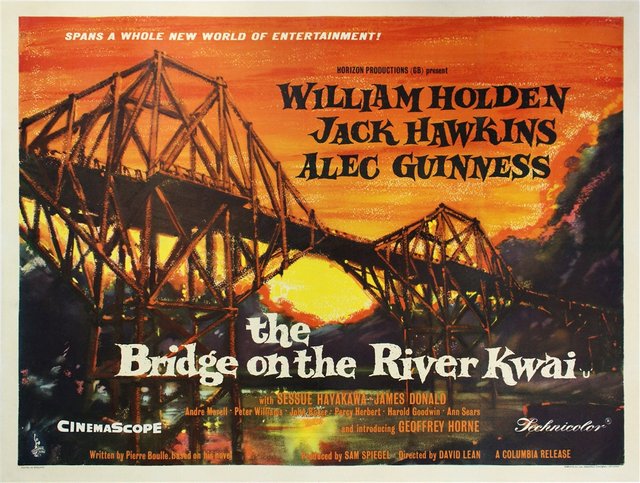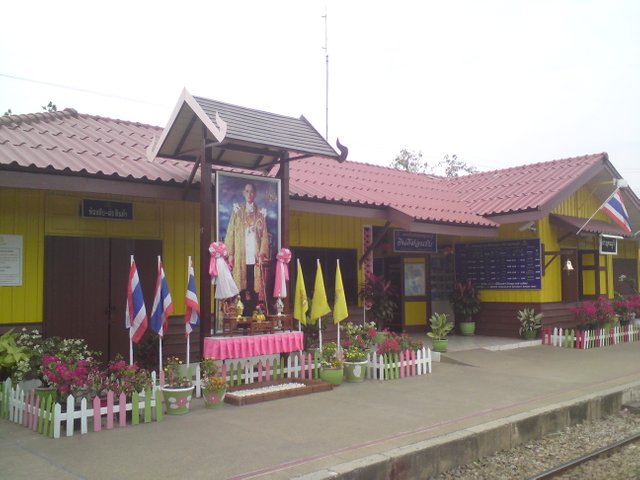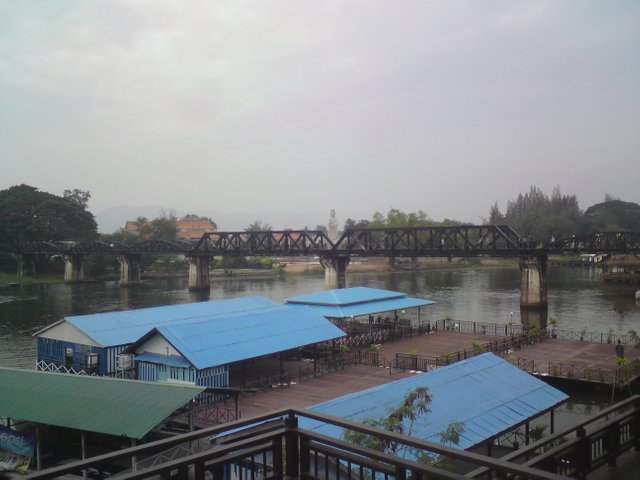Kanchanaburi, The Bridge Over the River Kwai and the Hunt for Sergeant Wright - Part 1
The bridge over the River Kwai is situated just outside the town of Kanchanaburi in western Thailand, and was made famous by a novel and a movie based on that novel. Both are fictionalised versions of a very dark period of history during the World War 2.
The Bridge over the River Kwai you see here is the original bridge, except for the two trapezoidal sections in the middle which the Japanese used to replace two arched sections after the war which had been destroyed by allied bombing.
The History
During the second world war, the Japanese and Thailand formed an agreement that Japan would be allowed to build a railway from Thailand to Burma so they could supply their troops, who had just defeated the British in Burma without the risk of sending the supplies by sea as allied submarines were hitting Japanese shipping hard around the Malay peninsula.
The Japanese used over 60,000 prisoners of war to build the 'Death Railway' as it became known and over 180,000 South East Asian 'volunteers' who were drafted in.
The line was originally 415km long and ran between Ban Pong, Thailand, and Thanbyuzayat, Burma and construction was started in June 1942. The task was immense, the line ran through mountainous terrain and jungles as well as over 600 bridges and the Japanese were merciless cruel taskmasters.
Before its completion in October 1943, over 12,000 POWs and 90,000 civilian workers had died of malnutrition, disease or had been killed.
The bridge over the River Kwai was originally a wooden, temporary construction finished in 1942 but was soon joined a year later in 1943 by the concrete and steel bridge we see today.
The bridge was damaged by bombs dropped by the RAF in February 1945 but quickly repaired by the allied POWs. On the 3rd of April, the USAF had a go with their Liberator heavy bombers dropping 1000lbs precision-guided bombs, but again the damage was repaired and trains ran across once more. The bridges, and subsequently the railway were finally put out of commission after a second huge air-raid by the RAF on June the 24th and no trains ran again before the Japanese surrendered in August the same year upon which, 3.9 kilometres of the original Japanese railway track on the Thai–Burma border were removed by the British Army . The rest of the railway was sold to Thai Railways by the British for 50million baht as part of reparations for their cooperation with the Japanese and the 130 km Ban Pong–Nam Tok section of railway was relaid and is still in use today, and as you will see, you can both walk across and take a train across.
How to Get There
Although there are both vans and buses that run from all Bangkok's major bus terminals, I'm not going to tell you about those! This story is about the railway and any other transportation method just wouldn't be right.
The wife attempting to force a smile in third class as we wait to depart Bangkok Noi, she doesn't share my fondness for rail travel!
So, trains run twice a day each way but from Bangkok Thonburi railway station, also known as Bangkok Noi which is on the west side of the Chao Praya river. However, on Saturdays and Sundays, there is a railcar special leaves from Hua Lampong early morning and comes back in the evening.
Train 257 leaves Bangkok Noi at 0750, arrives at Kanchanaburi at 1025, River Kwai Bridge Station at 1044 and Nam Tok at 1230
Train 259 leaves Bangkok Noi at 1355, arrives at Kanchanaburi at 1624, River Kwai Bridge Station at 1633 and Nam Tok at 1830
and coming back....
Train 260 leaves Nam Tok at 0520, arrives River Kwai Bridge Station at 0712, Kanchanaburi at 0717 and gets back to Bangkok Noi at 1025
Train 258 leaves Nam Tok at 1255, arrives River Kwai Bridge Station at 1440, Kanchanaburi at 1445 and gets back to Bangkok Noi at 1740
Except if I'm being honest, it probably won't as Thai trains are notorious for their arrival punctuality. All part of the fun!
The cost of all this is an incredibly reasonable 100Baht (£2.20, $3.00) each way, Bangkok to Nam Tok.
The trains from Bangkok Noi are strictly third-class so you simply turn up and buy a ticket. No reservations and if there aren't any seats, you're standing!
Third class isn't too bad when you get clattering through the countryside with all the windows open and it's very sociable with plenty of vendors walking up and down the carriages selling snacks and drinks.
Like all Thai railway stations, Kanchanaburi is small and very neatly kept
The train runs all the way to Kanchanaburi, then onto River Kwai Bridge station before running over the bridge, very slowly to avoid the tourists walking the bridge, and onto Nam Tok via the incredible Wampo Viaduct. Another nip your cheeks moment!
This is why I hate travelling with the wife. I can't take a photo without her having to be on it. It could be worse, I could have posted the one with me on instead!
.jpg)
Wampo Viaduct, like I said, nip your cheeks! (photo courtesy of maninseat61.com)
Kanchanaburi and the Riverside
It's a very odd place to be honest. Knowing about the history and the war cemeteries, I was expecting quite a sombre place with an air of dignity. But no, its actually a hugely popular tourist town now because of the bridge and its infamy and a lot of the history and meaning seems to have been sadly lost. There are party boats full of backpackers chugging up and down the river for 18 hours a day blaring out very loud music, I had unfortunately booked a lodge for the night on the riverside!
A plaque attempting to explain the history of the railway and the bridge without actually mentioning any of the Thai's involvement in the war!
There is a huge market by the bridge which kind of drowns out and smothers the war memorials and small museums there, and the bridge itself is swarming with tourists taking pictures. We actually left the train at Kanchanaburi station and had a quick look at the small war cemetery there first and then walked to the bridge, passing a motley assortment of dodgy bars and massage parlours on the way.
If you're staying over for a night or two as many people, and backpackers on their way to Myanmar do, there is a plethora of accommodation from hostels to top class hotels and everywhere in between, all easily bookable through one of the online booking sites. Plenty of motorcycle rentals too which is good as there are a few nice places to visit and temples just out of town, and they cost the standard 300B a day to hire.
No £250 fines for trespassing on the railway in Thailand!
There are a few little museums including my favourite, the Thailand-Burma Railway Centre, and the JEATH War Museum which is a very sobering place with a lot of weaponry and artefacts from the time. If you venture to the end of the line at Nam Tok and then go on by land to visit the Hellfire Pass, there is an even better museum there sponsored by the Australian government. Going further North from Hellfire Pass, the Australian Government has also cleared 7km of the old track bed from Hellfire Pass to Compressor Cutting which I am told is a stunningly beautiful and moving experience.

Hellfire Pass (picture courtesy of cnn.com)
The Book, Movie and double quick change of name!
The book, The Bridge Over the River Kwai, or Le Pont de la Riviere Kwai (1952) to give it its exact title as the writer, Pierre Boule was French, was a novel based on the historical setting of the Burma Railway.
The movie, directed by David Lean was released in 1957 and managed to win an impressive seven Oscars at the 30th Acadamy awards including 'Best Picture'.
Many historical and factual inaccuracies were pointed out by critics, but they appeared to forget the whole thing was a work of fiction simply based upon a factual event and location.

The Thais couldn't have been more pleased. The actual Bridge over the River Kwai suddenly became an instant tourist attraction. However, there was a problem.
The movie had been shot on location in Sri Lanka, but worse than that, the original writer of the book, Pierre Boule, had never even been to Thailand but just knew, the railway ran alongside the River Kwai for a great distance and assumed it was said river that the bridge crossed.
Assumptions are dangerous things to make, and so it came to pass that that the Bridge over the River Kwai was actually the Bridge over the River Mae Khlung. Hmmm, doesn't have the same ring to it really does it?
The Thais are an ingenious lot and in a flash of inspiration to save their expanding golden tourist goose did what any right-minded country would do; They renamed the river! As there was already a River Kwai, they renamed that the River the Kwai Noi (little Kwai) and the river that flowed under the bridge, the River Kwai Yai (big Kwai). Pleased with their success, they continued and continue to this day to promote the bridge and Kanchanaburi as a major tourist destination.
So now I'm going to leave the touristy stuff behind and Part 2 tomorrow will be more about the human element of the bridge and the war that raged around it as we say hello to Sergeant Wright.
.JPG)
.JPG)

.JPG)

.JPG)
.JPG)
.JPG)
.JPG)
Hiya, just swinging by to let you know that this post made the Honorable Mentions list in our daily Travel Digest. Please drop by to check out all the rest of today's great posts and consider upvoting the Travel Digest if you like what we're doing.
Congratulations! Your high quality travel content caught our attention and earned you a reward, in form of an upvote and resteem. Your work really stands out. Your article now has a chance to get curated and featured under the appropriate daily topic of our Travelfeed blog. Thank you for using #travelfeed
Learn more about our travel project on Steemit by clicking on the banner above and join our community on Discord
Thank you so much. :-)
Congratulations, Your Post Has Been Added To The Steemit Worldmap!
Author link: http://steemitworldmap.com?author=nathen007
Post link: http://steemitworldmap.com?post=kanchanaburi-the-bridge-over-the-river-kwai-and-the-hunt-for-sergeant-wright-part-1
Want to have your post on the map too?
Stunning .. brilliant, super, great.
Travel is a lively col.lege, suitable for you
Well performed on the images .. for extra creativity
Congratulations @nathen007! You have completed the following achievement on Steemit and have been rewarded with new badge(s) :
Click on the badge to view your Board of Honor.
If you no longer want to receive notifications, reply to this comment with the word
STOPThis post has received a 31.58 % upvote from @booster thanks to: @nathen007.
You got a 12.49% upvote from @upmewhale courtesy of @nathen007!
Earn 100% earning payout by delegating SP to @upmewhale. Visit http://www.upmewhale.com for details!
As a follower of @followforupvotes this post has been randomly selected and upvoted! Enjoy your upvote and have a great day!